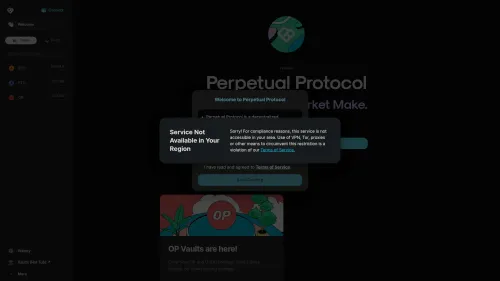Perpetual Protocol (PERP)
Perpetual Protocol (Symbol: PERP) is a decentralized perpetual contract protocol designed for various assets. It utilizes a Virtual Automated Market Maker (vAMM) to facilitate its operations. PERP, the native token, plays a crucial role in governance and staking on the platform.
Understanding perpetual contracts
A perpetual contract is a derivative similar to a futures contract but without an expiration date. In traditional futures contracts, the price tends to align with the underlying asset's spot market price as the expiration date nears. Perpetual contracts, however, automatically roll over every few hours. To maintain alignment with the underlying index, one party pays the other a funding rate, reflecting the cost of capital and the futures curve's slope.
PERP Protocol
Perpetual Protocol operates similarly to Uniswap, allowing traders to engage with vAMMs directly without counter parties. These vAMMs ensure on-chain liquidity with predictable pricing through constant product curves and are designed to be market-neutral and fully collateralized.

| Ticker | PERP |
| Category | Decentralized Exchange (DEX) |
| Website | https://app.perp.com |
| @perpprotocol | |
| Telegram | perpetualprotocol |
| Contract Addresses | |
|---|---|
| ethereum | 0xbc...47 Copied! Copied! |
| xdai | 0x7e...79 Copied! Copied! |
| optimistic-ethereum | 0x9e...e0 Copied! Copied! |
| arbitrum-one | 0x75...ac Copied! Copied! |
| binance-smart-chain | 0x4e...f5 Copied! Copied! |
Staking is an integral part of the protocol, where PERP holders can become stakers by staking their tokens in the Staking Pool. In return, they receive transaction fees in stablecoins and staking rewards in PERP.
In August 2020, Perpetual Protocol raised $1.8 million in a strategic round led by Multicoin Capital, with participation from notable investors such as Zee Prime Capital, Three Arrows Capital, CMS Holdings, LLC, and Alameda Research.
Virtual AMMs (vAMMs)
Perpetual Protocol differentiates itself by using the constant-product curve in their vAMMs solely for price discovery, enabling leverage and short positions. This approach led to the term "Virtual AMMs," distinguishing them from traditional AMMs used for token swaps and price discovery.
PERP Token
The PERP token is the native ERC-20 token of Perpetual Protocol, supporting staking and governance. The total supply is capped at 150,000,000 tokens. Although the supply can be increased through governance decisions or to cover insurance fund shortfalls, these scenarios are rare.
PERP token distribution
- Balancer Liquidity Bootstrapping Pool (LBP): 7,500,000 PERP (5.0%) for the token launch in September 2020.
- Seed investors: 6,250,000 PERP (4.2%) for Binance Labs' early development investment.
- Strategic investors: 22,500,000 PERP (15%) allocated to strategic investors.
- Team and advisors: 36,000,000 PERP (21%) for the team and advisors involved in launching Perpetual Protocol.
- Ecosystem and rewards: 77,750,000 PERP (54.8%) for ecosystem participants, including traders, stakers, and community developers.
Governance
PERP token holders can stake their tokens and participate in governance by voting on or proposing improvements. Initially, core protocol contributors guide critical decisions until the on-chain governance platform is fully operational.
Staking
PERP holders can stake their tokens in the Staking Pool for a specified period, earning staking rewards in return. This process supports the protocol's operation and incentivizes participation.
How it works
Step 1
A user sends 100 USDT to the Clearing House on Perpetual Protocol, using it as margin to open a 2x leveraged long position. The Clearing House records position ownership, initial margin, leverage level, and position direction.
Steps 2 and 3
The Clearing House deposits the 100 USDT to the Vault and updates the vAMM with the margin amount, position side, and leverage level. Unlike other AMM applications, Perpetual Protocol uses its vAMMs for price discovery, allowing for leverage and shorting.
Steps 4 and 5
Assuming an initial state of 100 ETH/USDT and 10,000 USDT in the vAMM, using 100 USDT as margin for a 2x leveraged long position changes the USDT amount in the vAMM to 10,200. The ETH/USDT amount adjusts to 98.04, calculated by the constant-product curve, with the resulting position recorded in the Clearing House.
Step 6
Another user enters a similar position and, upon closing, realizes a profit based on their position and market conditions.
Team
- Yenwen Feng: Co-founder
- Shao-Kang Lee: Co-founder
- Yuren Ju: Senior Software Engineer
- Kimi Wu: Blockchain Developer
- Weiting Chen: Growth Manager
Investors
Perpetual Protocol has attracted investments from several distinguished firms, including:
- Alameda Research
- Binance Labs
- CMS
- Divergence Ventures
- Three Arrows Capital
- Mechanism Capital
- Multicoin Capital
- Zee Prime Capital
